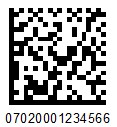Barcode syntax – The use of GS1 Element String (Application Identifiers (AI))
GS1 application identifiers (AI) are numeric prefixes used in barcodes to define the meaning of and syntax of information elements. AIs makes it possible to separate different information elements from one another in a barcode. In the text below or next to a barcode, these appear as numbers in parentheses and the content of the individual AI follows accordingly. A GS1 barcode is required to use AIs.
GS1 has defined over 100 application identifiers (AIs). Each application identifier is a standard two-, three- or four-digit number code. For the full list of GS1 application identifiers and their definitions, see section 3.2 of the GS1 General Specification.

Barcode with AI 15 for «Best before date».

Barcode with AI 17 for «Expiry date».
Barcode size
The physical size of a 2D barcode varies according to the amount of information contained in it. The resolution of the barcode (X-dimension) must be a minimum of 0.375mm and a maximum of 0.990mm when using GS1 AI syntax in the barcode on a consumer unit.
The resolution of the barcode (X-dimension) must be a minimum of 0.396 and a maximum of 0.990mm when using GS1 Digital Link URI syntax in the barcode on a consumer unit.
Barcode quality and life span
2D barcodes are verified according to the ISO standard ISO / IEC 15415. This is an international standard that describes the quality requirements for barcodes and the readability. Highest grade is 4.0 / 20/660. The minimum requirement is 1.5 / 20/660. The numbers indicate; character / aperture / wavelength of the light illuminating the barcode.
The life span of a barcode depends on the type of label material used and where / how the label is placed on the product. Label material / printing method must be chosen that has at least as long a shelf life as the assessed shelf life of the product to be labelled.
Placement of the barcode on the product
If 2 barcodes are placed on the product, a linear and a 2D barcode for use in POS or a linear and a GS1 Digital Link for consumer communication or two 2D barcodes for both POS and consumer communication, efforts should be made to place them adjacent on the packaging. This ensures that the barcode is read regardless of which barcode contains what you want to read. Programming the barcode scanners to ignore the type of code that should not be read will prevent erroneous readings.
Readability of the barcode
The readability of the barcode depends on the size of the barcode, the type of barcode reader and the distance from the barcode to the barcode reader. If the requirements for size and quality are followed, this is in accordance with industry standards and the barcodes can be read at a normal distance with normal equipment.
GS1 Datamatrix with Element String (AI’s) syntax for POS purposes
The GS1 AI structure is the same solution that is used to structure data used in the GS1-128 barcode on Trading units and pallets today. This solution will fill all the needs of the industry to get better traceability right down to the checkout (POS) and it provides the necessary information to get better shelf-life control, and to automatic price down products that are approaching the expiration date in time to minimize food waste in stores. A minimum information width has been defined for POS purposes.
This is:
- GTIN
- Best before date or Expiry date
- Batch/lot nr.
- Net Weight (for variable measure products).
This does not mean that other information elements cannot be entered in the barcode, but this will increase the physical size of the barcode. It is not necessary to have all the information in human readable text next to or below the barcode if this information is elsewhere on the label. However, it is recommended that the minimum GTIN is in human readable text in connection with the barcode (as the example on the right).


